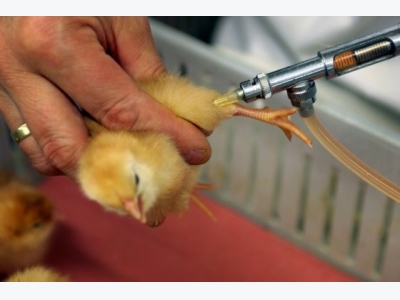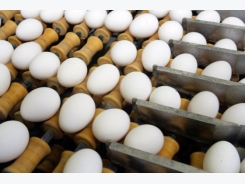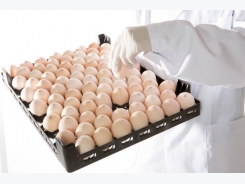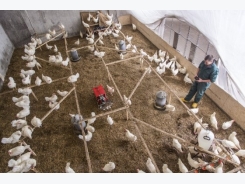Vaccine atomisation promising for influenza immunisation

A few more research steps to go and then mass vaccination of poultry against bird flu will be a viable option. This is according to professor of vaccinology Anke Huckriede of the University of Groningen. Good immunisation can be ensured by atomisation of the vaccine in the poultry house.
Mass vaccination against avian influenza will not work with traditional innoculation methods. Vaccine atomisation in the poultry house opens possibilities. Photo: Marco Vellinga
As professor of Vvccinology of the Department of Medical Microbiology of the University Medical Center Groningen, Anke Huckriede oversees the research done in developing possibilities of mass vaccination of poultry. The best way of mass vaccination of poultry is via inhalation through the lungs. Hence, in February 2013 a Dutch consortium consisting of scientists from the University of Groningen, the University Medical Center Groningen, Utrecht University and the Central Veterinary Institute in Lelystad, started with a first research project. The name of this project is ‘Pulmonary vaccination of chickens against avian influenza using an inactivated virus vaccine’.
Powder vaccine administered through the airways
In 2014 the main results of this research were published in the medical-scientific journal Vaccine. Huckriede: “In this study we have shown that by means of a powder vaccine administered through the airways we can induce an immune response in poultry. The trick to turn a liquid vaccine into a stable, dry powder was invented by my colleagues, professor Erik Frijlink and doctor Wouter Hinrichs of the University of Groningen. Next to the fact that we could immunise animals by administration of a dry powder via the lungs, it’s also special that we could do so using an inactivated vaccine. Before, inoculation by the airways only succeeded with a vaccine consisting of live virus particles.” The atomised fine powder particles can be inhaled by the birds. In the long run this opens possibilities for mass-vaccination.
First results show full protection
Huckriede admits that the developed methods cannot be fielded yet, however, the first results show that full protection of the animals against disease symptoms associated with bird flu could be achieved when the vaccine powder was directly administered to the lungs of the poultry. In addition, excretion of virus in those vaccinated animals was reduced to practically zero. Huckriede: “We also have done a test, to measure the effect of atomising the vaccine in a box and letting chickens inhale the powder vaccine for 10 minutes. We saw that chickens vaccinated by this method successfully mounted an immune response. Yet the response wasn’t as strong as that of chickens which got the vaccine directly blown into the lungs. Nevertheless, when infected chickens were vaccinated by inhalation, they became less sick than non-vaccinated controls.”
Next step is to examin a more powerful vaccine
Vaccination also had a visible though modest effect on virus transmission by the poultry. These results show that chickens can be vaccinated successfully through the air. According to the Professor of Vaccinology the next step is to examine if a more powerful vaccine, a higher vaccine dose and/or longer exposure to the vaccine can improve the immune response and achieves complete immune response and a full blockade of virus transmission.
Professor Huckriede admits that the developed methods cannot be fielded yet, however, the first results show that full protection of the animals against disease symptoms associated with bird flu could be achieved.
Further optimisation needed
Before complete protection against avian influenza can be guaranteed, the administration and the vaccine itself will have to be further optimised in practice, according to Huckriede. That is why the Dutch consortium started in June 2016 with a second research project in the follow-up of ‘Pulmonary vaccination of poultry against avian influenza: mass application of a safe inactivated vaccine’. Tests were done with improved versions of the previously used powder vaccine. One of the adjustments was that an adjuvant, an immune-stimulating substance, was added to the new vaccine that will help to generate an even better immune reaction. “We are currently collecting the data of this second test, around February 2017 we expect to know the results,” says Huckriede.
Universal vaccine
Yet, even with a safe, effective and easy to administer vaccine there is still the problem of sufficient production capacity at the time when mass-vaccination is needed. According to Huckriede the adjuvant currently added to the vaccine can be produced in large quantities in advance. “But you’re still left with the problem of the production of the vaccine itself. At the moment in the Netherlands and in Europe there are too few production facilities and thus too little production capacity to produce a vaccine for poultry on such a large scale,” says Huckriede. “Another characteristic of the avian flu virus is that it mutates or changes very quickly. That requires that you have to be very quick in producing large amounts of the right vaccine in case of an outbreak.” Hence, the Dutch consortium, as well as a number of other consortia in the world, is also investigating a universal vaccine that works against a wide range of avian influenza strains. “As University of Groningen and University Medical Center Groningen, we are also project leader and partner in the European consortium UNISEC that aims at developing universal flu vaccines for humans. A big advantage of this is that for the development of a universal vaccine for people much more money is available.”
European and global poultry industry hesitant
The fact that the European and global poultry industry is hesitant with respect to mass-vaccination is very logical according to Huckriede. “It takes not only a lot of money, they are also afraid that after inoculation of poultry with an avian influenza vaccine, wild virus strains in poultry populations will become more difficult to detect. Vaccinated animals will no longer get sick, but might still spread the virus. Surveillance for circulating virus is performed by measuring bird flu antibodies in the blood of the animals and such antibodies are present in both vaccinated as well as in infected animals.” This may interfere with the trade and export of poultry and poultry products. Given the large-scale Dutch export, it is therefore logical that the Dutch poultry sector, according to Huckriede, first wants security. “Fortunately, plenty of research is done into marker vaccines which distinguish infected animals from vaccinated animals, this is the so-called DIVA approach (differentiating infected from vaccinated animals). Huckriede: “So the most promising vaccines are, in my opinion, universal powder vaccines that can be easily administered through atomisation in the air, offer a high level of protection and can be clearly and conclusively distinguished by a marker. With such a vaccine the economically and socially undesirable cull of thousands of healthy animals at times of bird flu outbreaks would belong to the past.”
Related news
Tools

Phối trộn thức ăn chăn nuôi

Pha dung dịch thủy canh

Định mức cho tôm ăn

Phối trộn phân bón NPK

Xác định tỷ lệ tôm sống

Chuyển đổi đơn vị phân bón

Xác định công suất sục khí

Chuyển đổi đơn vị tôm

Tính diện tích nhà kính

Tính thể tích ao




 Laying hens stick to their own routine
Laying hens stick to their own routine  Interview: Is robotic egg collection the future?
Interview: Is robotic egg collection the future?